Highly conserved glycine 86 and arginine 87 residues contribute differently to the structure and activity of the mature HIV-1 protease
Ishima, R., Gong, Q., Tie, Y., Weber, I.T., Louis, J.M.(2009) Proteins 78: 1015-1025
- PubMed: 19899162
- DOI: https://doi.org/10.1002/prot.22625
- Primary Citation of Related Structures:
3JVW, 3JVY, 3JW2 - PubMed Abstract:
The structural and functional role of conserved residue G86 in HIV-1 protease (PR) was investigated by NMR and crystallographic analyses of substitution mutations of glycine to alanine and serine (PR(G86A) and PR(G86S)). While PR(G86S) had undetectable catalytic activity, PR(G86A) exhibited approximately 6000-fold lower catalytic activity than PR. (1)H-(15)N NMR correlation spectra revealed that PR(G86A) and PR(G86S) are dimeric, exhibiting dimer dissociation constants (K(d)) of approximately 0.5 and approximately 3.2 muM, respectively, which are significantly lower than that seen for PR with R87K mutation (K(d) > 1 mM). Thus, the G86 mutants, despite being partially dimeric under the assay conditions, are defective in catalyzing substrate hydrolysis. NMR spectra revealed no changes in the chemical shifts even in the presence of excess substrate, indicating very poor binding of the substrate. Both NMR chemical shift data and crystal structures of PR(G86A) and PR(G86S) in the presence of active-site inhibitors indicated high structural similarity to previously described PR/inhibitor complexes, except for specific perturbations within the active site loop and around the mutation site. The crystal structures in the presence of the inhibitor showed that the region around residue 86 was connected to the active site by a conserved network of hydrogen bonds, and the two regions moved further apart in the mutants. Overall, in contrast to the role of R87 in contributing significantly to the dimer stability of PR, G86 is likely to play an important role in maintaining the correct geometry of the active site loop in the PR dimer for substrate binding and hydrolysis. Proteins 2010. (c) 2009 Wiley-Liss, Inc.
Organizational Affiliation:
Department of Structural Biology, University of Pittsburgh School of Medicine, Pittsburgh, Pennsylvania 15260, USA. ishima@pitt.edu

















